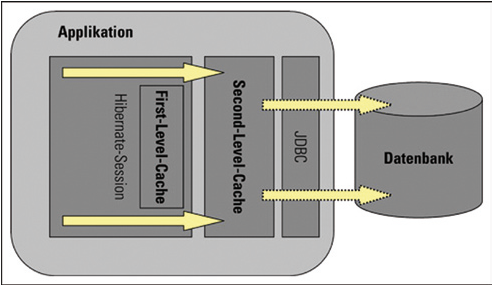Hibernate的一级缓存和二级缓存
- Fist level cache: This is enabled by default and works in session scope. Read more about hibernate first level cache.
- Second level cache: This is apart from first level cache which is available to be used globally in session factory scope.
一级缓存(不能disable):
- First level cache is associated with “session” object and other session objects in application can not see it.
- The scope of cache objects is of session. Once session is closed, cached objects are gone forever.
- First level cache is enabled by default and you can not disable it.
- When we query an entity first time, it is retrieved from database and stored in first level cache associated with hibernate session.
- If we query same object again with same session object, it will be loaded from cache and no sql query will be executed.
- The loaded entity can be removed from session using evict() method. The next loading of this entity will again make a database call if it has been removed using evict() method.
- The whole session cache can be removed using clear() method. It will remove all the entities stored in cache.
二级缓存默认是disable,需要自己配置

How second level cache works:
Lets write all the facts point by point:
- Whenever hibernate session try to load an entity, the very first place it look for cached copy of entity in first level cache (associated with particular hibernate session).
- If cached copy of entity is present in first level cache, it is returned as result of load method.
- If there is no cached entity in first level cache, then second level cache is looked up for cached entity.
- If second level cache has cached entity, it is returned as result of load method. But, before returning the entity, it is stored in first level cache also so that next invocation to load method for entity will return the entity from first level cache itself, and there will not be need to go to second level cache again.
- If entity is not found in first level cache and second level cache also, then database query is executed and entity is stored in both cache levels, before returning as response of load() method.
- Second level cache validate itself for modified entities, if modification has been done through hibernate session APIs.
- If some user or process make changes directly in database, the there is no way that second level cache update itself until “timeToLiveSeconds” duration has passed for that cache region. In this case, it is good idea to invalidate whole cache and let hibernate build its cache once again. You can use below code snippet to invalidate whole hibernate second level cache.
refer:https://howtodoinjava.com/hibernate/understanding-hibernate-first-level-cache-with-example/
https://howtodoinjava.com/hibernate/how-hibernate-second-level-cache-works/
Hibernate的一级缓存和二级缓存的更多相关文章
- 【转】hibernate缓存:一级缓存和二级缓存
什么是缓存? 缓存是介于物理数据源与应用程序之间,是对数据库中的数据复制一份临时放在内存中的容器,其作用是为了减少应用程序对物理数据源访问的次数,从而提高了应用程序的运行性能.Hibernate在进行 ...
- Hibernate中的一级缓存、二级缓存和懒加载(转)
1.为什么使用缓存 hibernate使用缓存减少对数据库的访问次数,从而提升hibernate的执行效率.hibernate中有两种类型的缓存:一级缓存和二级缓存. 2.一级缓存 Hibenate中 ...
- Hibernate一级缓存与二级缓存的区别
一级缓存: 就是Session级别的缓存.一个Session做了一个查询操作,它会把这个操作的结果放在一级缓存中. 如果短时间内这个session(一定要同一个session)又做了同一个操作,那么h ...
- Hibernate中一级缓存和二级缓存使用详解
一.一级缓存二级缓存的概念解释 (1)一级缓存就是Session级别的缓存,一个Session做了一个查询操作,它会把这个操作的结果放在一级缓存中,如果短时间内这个 session(一定要同一个ses ...
- Hibernate中的一级缓存、二级缓存和懒加载
1.为什么使用缓存 hibernate使用缓存减少对数据库的访问次数,从而提升hibernate的执行效率.hibernate中有两种类型的缓存:一级缓存和二级缓存. 2.一级缓存 Hibenate中 ...
- hibernate缓存:一级缓存和二级缓存
1.什么是缓存? 缓存是介于物理数据源与应用程序之间,是对数据库中的数据复制一份临时放在内存中的容器,其作用是为了减少应用程序对物理数据源访问的次数,从而提高了应用程序的运行性能.Hibernate在 ...
- Hibernate一级缓存和二级缓存深度比较
1.什么是缓存 缓存是介于应用程序和物理数据源之间,其作用是为了降低应用程序对物理数据源访问的频次,从而提高了应用的运行性能.缓存内的数据是对物理数据源中的数据的复制,应用程序在运行时从缓存读写数据, ...
- Hibernate一级缓存和二级缓存详解
(1)一级缓存 是Session级别的缓存,一个Session做了一个查询操作,它会把这个操作的结果放在一级缓存中,如果短时间内这个session(一定要同一个session)又做了同一个操作,那么h ...
- Hibernate之一级缓存和二级缓存
1:Hibernate的一级缓存: 1.1:使用一级缓存的目的是为了减少对数据库的访问次数,从而提升hibernate的执行效率:(当执行一次查询操作的时候,执行第二次查询操作,先检查缓存中是否有数据 ...
- Hibernate 的一级缓存和二级缓存总结
缓存:缓存是什么,解决什么问题? 位于速度相差较大的两种硬件/软件之间的,用于协调两者数据传输速度差异的结构,均可称之为缓存Cache.缓存目的:让数据更接近于应用程序,协调速度不匹配,使访问速度更快 ...
随机推荐
- Collection集合工具类
Ⅷ.Collections 工具类 java.util.Collections Collections 集合工具类,用来对集合进行操作,部分重要方法如下: 1.public static <T& ...
- linux U盘安装系统工具usb-creator-gtk
linux平台下U盘安装linux系统的工具.它是ubuntu自带的工具,将建时将覆盖U盘中的所有内容.
- 简单快速安装Apache+PHP+MySql服务环境(一)
由于自己只是普通的coder,对于服务器的操作不是很熟悉,在网上找了很多关于PHP和apache服务器环境搭建的帖子,不过都不尽相同,尤其是编译安装更是看的云里雾里的,所以选择了一种比较简单的方式进行 ...
- jenkins资源下载地址(软件、插件等)
jenkins资源下载地址(软件.插件等) 1. 镜像1:清华镜像 2 .镜像2:http://mirrors.jenkins-ci.org/ 3. 官方下载地址:https://jenkins.io ...
- 添加底部导航栏tabbar
效果图: 如果要添加底部导航栏,最少2个,最多5个. app.json { "pages": [ "pages/index/index", "page ...
- Electron 开发音视频
废话不多说,咱直接进入正题! 创建 Electron 项目 前提条件 在使用Electron进行开发之前,需要安装 Node.js. 要检查 Node.js 是否正确安装,请在您的终端输入以下命令: ...
- 作为Java开发工程师,如何高效优雅地编写接口文档
作为一名优秀的Java开发工程师,编写接口文档向来是一件很头疼的事情.本来就被bug纠缠的很累了,你还让我干这? 其实,你可以试试ApiPost. ApiPost的定位是Postman+Swagger ...
- 第1篇-关于JVM运行时,开篇说的简单些
开讲Java运行时,这一篇讲一些简单的内容.我们写的主类中的main()方法是如何被Java虚拟机调用到的?在Java类中的一些方法会被由C/C++编写的HotSpot虚拟机的C/C++函数调用,不过 ...
- 方法对了,你做1年Android开发能顶别人做10年
前几天后台有读者问我这样的问题.他在一家互联网公司工作3年了,每天都很忙,事情又多又杂. 本想着学习多一些东西也不是坏事,可到头来一无所获,什么都没学会,满腔的热情也被消磨得差不多. 三天两头动辞职的 ...
- SpringBoot-技术专区-用正确的姿势如何用外置tomcat配置及运行(Tomcat优化分析)
前提概要 在特别特殊的时候,我们可能需要外置tomcat去运行程序,例如alitomcat等特殊场景,方便我们去定时化开发项目或者其他特殊场景. 外置tomcat执行 pom.xml文件首先更改打包方 ...
